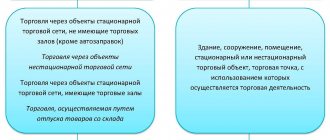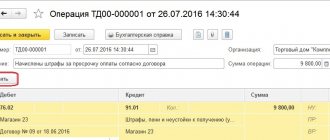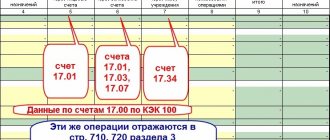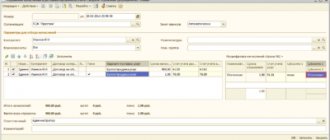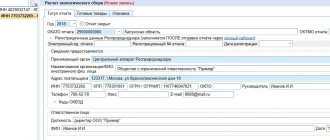General concepts of trade tax
A trade fee is a mandatory payment that the payer makes in exchange for obtaining the right to engage in trading activities. This definition can be given in accordance with the Tax Code of the Russian Federation.
The law providing for payment of the right to trade in the form of a fee was issued in 2015 and supplemented the Tax Code with Articles 411 and 412 of the Tax Code of the Russian Federation. As of today, according to the law, it applies only to cities of federal significance, such as Moscow, St. Petersburg and Sevastopol.
The conditions for paying the fee vary depending on the system on which the payer is located. As is known, they are distinguished as:
Trade fee
- general
- simplified
- single concubines
- and others
Some systems are generally exempt from this payment. It is worth noting that it is called a fee, and not a tax, since a number of taxpayers, again depending on the taxation system, may attribute it to expenses, thereby reducing the tax base.
The project provides that other municipalities will be able to introduce a tax on trade in other regions, but before the relevant law is issued by the federal authorities.
How do trade tax payers complete a tax return?
The “simplified” people did not rejoice for long at the new form of the declaration: it no longer corresponds to the changes made to the Tax Code of the Russian Federation.
The currently valid form of declaration for tax paid in connection with the use of the simplified tax system, as well as the procedure for filling it out, approved by Order of the Federal Tax Service of the Russian Federation dated July 4, 2014 No. ММВ-7-3 / [email protected] , do not provide for the ability to reflect in the declaration the amount of trade fee paid during a given tax (reporting) period in order to reduce the amount of tax (advance payment thereof) paid in connection with the application of the simplified tax system, calculated based on the results of the tax (reporting) period.
The Tax Service gives the following recommendations on this issue ( Letter dated August 14, 2015 No. GD-4-3/ [email protected] “On the procedure for accounting for trade tax amounts by taxpayers using the simplified tax system” ).
Before making changes to the declaration form and the procedure for filling it out, trade tax payers are recommended to reduce the amount of tax (advance tax payment) calculated in the declaration by the trade tax amounts paid during a given tax (reporting) period by reflecting them on an accrual basis on lines 140 - 143 of section . 2.1 declarations together with the amounts of insurance premiums paid to employees of temporary disability benefits and payments (contributions) under voluntary personal insurance contracts, which are provided for in clause 3.1 of Art. 346.21 Tax Code of the Russian Federation .
At the same time, such taxpayers who indicated attribute “1” on line 102 (a taxpayer making payments and other remuneration to individuals) are not subject to the 50% limitation (the values of lines 140 – 143 should not be more than 1/2 of the amount of the calculated tax ( advance tax payments)).
Registration with the tax authority
The Federal Tax Service compiles a separate register to record taxpayers of this fee. A person is included in the register on the basis of a notification provided for in Art. 416 of the Tax Code of the Russian Federation.
It can be sent by mail, delivered in person or electronically using the official website.
Taxes
From the moment of receiving this document, the tax office is obliged to process the information and register the person no longer than five days, after which, over the next 5 days, the payer is sent a certificate of registration. These actions are provided for in paragraph 3 of Art. 416 of the Tax Code of the Russian Federation.
In general, 10 days pass from the moment the taxpayer contacts the Federal Tax Service until final registration. If for any reason an entrepreneur decides to terminate his activities, he must be deregistered as a trade tax payer. To do this, he must fill out the appropriate notification and submit it to the tax authority at the place of registration.
Accounting for trade tax under the simplified tax system with the object “income” - new features of “1C: Accounting 8” ed. 3.0
In “1C: Accounting 8” (rev. 3.0), starting with version 3.0.42.72, it became possible to automatically calculate tax on the simplified tax system with the object “income” for payers of trade tax.
Now the program supports the method of separate accounting of income and expenses for activities subject to trade tax as part of activities on the simplified tax system for the application of paragraphs 3. and 8 of Article 346.21 of the Tax Code of the Russian Federation in accordance with the recommendations of the Ministry of Finance of the Russian Federation. On July 1, 2015, Moscow Law No. 62 dated December 17, 2014 introduced a trade tax in the capital. For taxpayers who use the simplified tax system with the object “income minus expenses” and pay a trade tax, keeping records under the new conditions should not cause difficulties. Such taxpayers fully take into account the amount of paid trade tax in expenses on the basis of paragraphs. 22 paragraph 1 of Article 346.16 of the Tax Code of the Russian Federation (letters of the Federal Tax Service of Russia dated 08/12/2015 No. GD-4-3/14233, Ministry of Finance of Russia dated 03/27/2015 No. 03-11-11/16902, dated 07/23/2015 No. 03-11-09/ 42494). But for simplifiers with the object “income”, who pay a trade fee and carry out several types of activities, accounting becomes significantly more complicated.
We remind you that with a simplified taxation system with the object “income” (hereinafter referred to as the simplified tax system “income”), the calculated amount of tax (advance payment) can be reduced by the expenses listed in paragraph 3.1 of Article 346.21 of the Tax Code of the Russian Federation. These expenses include insurance premiums paid in the current tax (reporting) period, temporary disability benefits, payments (contributions) under voluntary personal insurance contracts. In this case, the amount of tax (advance tax payments) can be reduced by no more than 50 percent.
In addition to the amounts established by clause 3.1, the taxpayer has the right to reduce the tax on the paid trade fee (clause 8 of Article 346.21 of the Tax Code of the Russian Federation). Please note that the 50% limit established for insurance premiums and benefits does not apply to the trading fee (letter of the Ministry of Finance dated October 7, 2015 No. 03-11-03/2/57373).
Keep in mind that if you simultaneously apply the simplified tax system “income” and pay a trade fee, you can reduce the tax calculated only in part of the type of business activity in respect of which the trade fee is established by the amount of the trade fee. Consequently, the named taxpayers, for the purpose of applying paragraph 8 of Article 346.21 of the Tax Code of the Russian Federation, are required to keep separate records of income (letter of the Ministry of Finance of the Russian Federation dated July 23, 2015 No. 03-11-09/42494). It turns out that paid contributions and benefits, by which the amount of tax is reduced, also need to be divided between types of activities subject to and not subject to trade tax. The methodology for separate accounting of income and expenses is not established by law.
For taxpayers using the simplified tax system “income” in “1C: Accounting 8” (rev. 3.0), the calculation of tax (advance payment) and the generation of tax reporting are fully automated and include:
- separate accounting of income in case of payment of trade tax;
- determining the amount of insurance premiums and benefits that reduce tax, taking into account the 50% limit;
- calculation of the tax amount taking into account paragraphs 3.1 and 8 of Article 346.21 of the Tax Code of the Russian Federation;
- filling out a tax return taking into account the recommendations of the Ministry of Finance.
In order to summarize information on settlements with customers for sales related to activities subject to the trade tax, off-balance sheet accounts have been added to the chart of accounts:
- USN.04 “Settlements with buyers for activities at the trade collection”;
- USN.24 “Settlements with buyers in foreign currency for activities at the trade fee.”
Settings for the calculation and accrual of trade fees are made in the Trade Fee form, which can be accessed via the hyperlink of the same name from the Directories - Taxes section. From the Trade Fee form, you can get to the Trade Points directory, where information is stored about the outlets for which the trade fee is paid, and to the regulated reporting form Notification of registration as a trade fee payer.
To ensure separate accounting of income from activities subject to a trade fee as part of the simplified tax system income, in the sales documents it is necessary to select the value Activities on a trade fee in the Income in NU field (Fig. 1).
Rice. 1. Accounting for income from activities at the trade fee
Similar choices are available in the following documents:
- Sales (deed, invoice);
- Retail sales report (when selling goods in a retail store and at a manual point of sale (NTP) when maintaining records at the cost of acquisition);
- Receipt of cash (in NTT when maintaining records at sales value).
In the documents Receipt of cash and Receipt to the current account, the advance received from the buyer can also be classified as income from activities subject to trade tax. To do this, in the Advance in NU field, select the value Income from activities on the trading fee.
For taxpayers using the simplified tax system for “income” who pay the trade fee, in the last month of the quarter, the processing of Month Closing includes, among other things, the following regulatory operations:
- Calculation of trade fee;
- Calculation of expenses that reduce the simplified tax system;
- Calculation of the simplified tax system.
When performing the operation Calculation of expenses that reduce the tax of the simplified tax system, according to the accounting system, paid insurance premiums and benefits that reduce the amount of tax are determined. Expenses related to activities subject to the trade tax are determined automatically in proportion to the income from this activity in the total amount of income (Fig. 2). For the calculation, data on the reflection of income in tax accounting by type of activity on an accrual basis from the beginning of the year until the end of the period of expenses is used. If necessary, expenses related to activities subject to trade tax can be reflected manually using the document Entry of the book of income and expenses of the simplified tax system (section Operations) on the IV Tax-reducing expenses tab.
. 2. The result of the distribution of expenses by activity at the trade fee
Automatic calculation of the tax on the simplified tax system “income” with the simultaneous payment of trade fees is carried out using the routine operation Calculation of tax on the simplified tax system. An explanation of the calculation can be obtained using the Help-calculation report of the tax paid in connection with the application of the simplified tax system (Fig. 3). The report contains a column reflecting the amounts of the trade fee that reduce the tax. There is also an additional table explaining the calculation of tax on activities subject to the trade tax and the procedure for calculating the trade tax deductible from the tax.
Rice. 3. Certificate of tax calculation under the simplified tax system and activities at the trade fee
The procedure for filling out the tax return paid in connection with the application of the simplified taxation system has been amended in accordance with the letter of the Federal Tax Service of Russia dated August 14, 2015 No. GD-4-3 / [email protected] Amounts of trade duty that reduce tax (advance payment ), are reflected on an accrual basis in lines 140-143 of the declaration together with the amounts of insurance premiums paid to employees of temporary disability benefits and payments (contributions) under voluntary personal insurance contracts provided for in paragraph 3.1 of Article 346.21 of the Tax Code of the Russian Federation.
IS 1C:ITS
- about the organization of tax accounting under the simplified tax system, see the reference book “Accounting when applying the simplified tax system” from the section “Accounting and tax accounting”, read the link https://its.1c.ru/db/accusn/content/217/hdoc/;
- For information about the trade fee, see the “Trade Fee” directory from the “Taxes and Contributions” section - follow the link https://its.1c.ru/db/taxtrfee.
Objects and tax rates
This fee is charged based on the area or number of retail outlets.
In the law it is referred to as a “trade facility”. This concept refers to stationary points, such as shops, tents, kiosks, etc., and also includes trade from mobile objects in the form of mobile shops.
It is worth noting that according to the law, a retail outlet, and therefore a warehouse, can be the object of taxation for this fee. This is only possible if goods are released from it. But since today the rate for them has not been determined, this type of trade is not subject to a trade tax.
Calculation example
In connection with all of the above, the issue remains uncertain regarding the activities of online stores. Despite the fact that the trade tax has been in effect for 2 years, today a decision has not yet been made on what to charge as an object of taxation when working with such entrepreneurs.
The size of the trade tax depends on the rate and the number of taxable objects. And it is determined by multiplying one indicator by another. In fact, this fee is currently valid only in Moscow. Therefore, tax rates should be taken into account within a given municipality. The rate depends on the taxable object.
The placement of the object also affects the size of the bet. In Moscow, 3 groups of districts have been identified that have different sales tax rates. The rate changes are observed from the center to the outskirts, downward. The rate is subject to annual indexation. Its size for the planning year can be found out from the Federal Tax Service.
Trade fee as an expense (under the simplified tax system “income minus expenses”): main correspondence
The first option for using trade tax (TC) in tax accounting is to include it in expenses. This is possible if:
- The payer works according to the simplified tax system of 15%.
In this case, the vehicle is included in expenses on a general basis and reduces the tax base (subclause 22, clause 1, article 346.16 of the Tax Code of the Russian Federation).
The accountant reflects the fact of payment of the vehicle and its inclusion in expenses in the accounting registers using correspondence: Dt 91.2 Kt 68 (sub-account “TS”).
- For some reason, the payer does not have the right to apply the vehicle as a deduction under the simplified tax system of 6% or the special tax system (for example, if he has not registered the retail facility).
In this case, vehicle amounts cannot be included in expenses for tax purposes (clause 19 of Article 270, clause 2 of Article 346.16 of the Tax Code of the Russian Federation). But it can be reflected in accounting using entries according to the following table.
| Dt | CT | Operation description |
| 68 (“TS”) | Vehicle accrual recorded | |
| 99 (“PNO”) | 68 (“Income tax”) | Fixed liability reflected |
| 68 (“TS”) | Payment of trade tax reflected | |
| 68 (“Income tax”) | 99 (“PNO”) | Reflects a decrease in PIT due to the use of a vehicle (in practice, it is not included in expenses and does not change the tax base) |
Another possible scenario is the use of TS as a deduction that reduces tax under the OSN (in terms of the regional payment - for corporate income tax, in full - for the personal income tax of an entrepreneur) or the simplified tax system “income”.
Accounting for trade fees in accounting
Enterprises that pay the trade tax differ in their form of ownership and size. Most of them, according to the law, are required to maintain accounting and tax records. As part of this, it is important to display the trade fee as transactions in accounting.
You can do this in one of three ways:
Accounting
- attributed to expenses related to core activities
- include in other expenses
- create a separate sub-account
Which of the above options is more appropriate depends on the volume of activity of the enterprise. The first option is possible for individuals who plan to reduce the amount of tax payment based on financial results paid to the budget of the city of Moscow. But only if the trade fee does not exceed this payment.
Calculating the possibility of tax reduction is very simple, since it is paid quarterly in the form of advance payments. For paying tax on a positive financial result, the deadline is the 28th day of the month following the quarter for which calculations are made. Consequently, even if the payer paid the fee on time, he has the opportunity to reduce the amount of tax, document this and make the payment.
Postings if sales tax is overcharged
Example 1 Based on the results for nine months of 2015, the advance payment of income tax for payment to the budget of the city of Moscow was calculated in the amount of 1,800 rubles, and the trade tax for the third quarter of 2015 was paid in the amount of 2,000 rubles. At the end of 2015, the income tax credited to the Moscow budget is 8,000 rubles.
, the amount of paid trade fee is 2,000 rubles. The following sub-accounts are opened in accounting: a) to account 68:68-P – income tax calculations; 68-T – trade tax calculations; b) to account 76:76-T – settlements for the trading fee. The following entries will be made in the accounting records of the trade organization.
transactions Debit Credit Amount, rub.
Accounting for trade fee: postings
Debit 44 Credit 68 – trading tax A trading tax has been accrued in a portion that exceeds the accrued income tax. If, based on the results of the reporting periods (in particular, the third quarter of 2015), a tax profit was received in the accounting of the enterprise and the trading fee was offset against the tax, and the calendar the year ended at a loss, the previously recorded trading fee will need to be restored and the expense reflected in the accounts. Example 2 Based on the results for nine months of 2015, an advance payment of income tax for payment to the city budget.
Moscow was calculated in the amount of 5,000 rubles, and the trade fee for the third quarter of 2015 was paid in the amount of 3,000 rubles. At the end of 2015, a tax loss was received; the amount of paid trade tax for the fourth quarter was 3,000 rubles.
The following entries will be made in the accounting records of the trade organization. transactions Debit Credit Amount, rub.
Trade fee reduces income tax: how to reflect it in accounting? (Manokhova S.V.)
In order to reduce the tax burden of entrepreneurs engaged in trade, the payment was classified as a fee. Thus, it not only reduces the number of taxes paid, but also allows you to reduce their amount.
In particular, income tax. This gives grounds to classify it as an expense. Select it and press Ctrl+Enter to let us know.
Trade fee: accounting entries, registration, payers
- Accounting of trade fees for income tax payers, No. 19
- How “profitable” simplifiers should reduce taxes on contributions, benefits and trade taxes, No. 19
- Trade fee and tax reduction: two things compatible?, No. 18
- Trade fee: who is the payer, No. 15
- Online pharmacy: legal or not?, No. 14
- Trade fee arrived in Moscow, No. 14
- Trade tax payers, register!, No. 14
- Goods from the exhibition, No. 13
- Trade fee in Moscow - 2015, No. 13
- Shortage during pickup: we analyze the consequences for the buyer and the supplier, No. 10
- Purchasing (reverse) factoring for the buyer, No. 10
- Return without an invoice - the legal right of the simplifier, No. 4
- Defective goods: emphasis when returning and replacing, No. 3
- Meet the new local tax - trading, No. 3
- 2014
Accounting entries for trading fees
Moscow is calculated in the amount of 1,800 rubles, and the trade fee for the third quarter of 2015 was paid in the amount of 2,000 rubles, then in the tax return the trade fee can be taken into account in reducing the advance payment only in the amount of 1,800 rubles.
If the amount of calculated income tax for payment to the budget of the city of Moscow at the end of 2015 exceeds the amount of paid trade tax for the third quarter (2,000 rubles) and for the fourth quarter (2,000 rubles) of 2015, then in the tax return for the calendar year the trade fee can be taken into account in reducing the tax in the total amount (RUB 4,000).
In our opinion, the amount of trading fee that cannot be taken into account against income tax in the current reporting period (if we take the figures from the commented letter - for the third quarter of 2015 - 200 rubles.
What is a trade fee
On July 1, 2015, the Federal Law of November 29, 2014 No. 382-FZ “On Amendments...” came into force in the Russian Federation, which regulates the procedure for applying a new type of deduction in the country - trade tax. This type of payment is paid by organizations related to the trade industry, provided that local governments have decided to implement a new type of fee.
https://www.youtube.com/watch?v=Ng4Ifp0Mgog
It is worth remembering that if the municipal authorities have introduced a fee for certain types of trade, then the special UTII regime cannot be applied to them, as evidenced by clause 2.1 of Art. 346.26 Tax Code of the Russian Federation.
More complete information about legislative innovations affecting trade entities can be read in the article “The Duma adopted the bill on municipal fees in the second reading”
Features of trade tax transactions
Taxpayers are required to independently calculate and transfer the fee to the budget. They may also be sent a demand for payment from the Federal Tax Service if the objects of trade are identified in a timely manner as a result of an inspection and have not previously been registered.
Example of reflection in accounting
In order to understand in detail how to display trade fees by postings in accounting, let's look at examples of postings. To do this, let’s simulate the situation with, the retail area of which was a total of 90 m2. The tax rate taking into account the location of its facility is 1,200 rubles. for 1 m2 up to 50 and 50 rubles. for every remaining meter. In this case, the amount of the fee was (50 x 1,200) + (40 x 50) = 62,000 rubles.
The easiest way to reflect a trade tax is if the payer has received a negative financial result. In this case, the amount is reflected as an expense in ordinary activities. It looks like this.
Dt 44 Kt 68 amount 62,000 rub. – trade tax is classified as a basic expense.
If the income tax exceeds the amount of the fee, the following entries are used:
- Dt 76 Kt 68 amount 62,000 rub. A trade fee has been charged.
- Dt 99 Kt 68 amount 262,000 rub. Profit tax has been charged.
- Dt 68 Kt 51 amount 62,000 rub. Trade tax paid.
- Dt 68 Kt 76 amount 62,000 rub. The cost associated with paying the fee is shown.
- Dt 68 Kt 51 amount 200,000 rub. Transfer of funds to the tax office, advance payment.
Please note that the example shows tax calculation and payment data for one quarter. But the calculation of the possibility of reducing income tax is determined by the annual value.
The trade tax was introduced with the aim of replenishing municipal budgets from funds collected from persons engaged in trading activities. In addition, the law allows authorities, through the Federal Tax Service, to maintain records and control of retail outlets in the city.
In order to reduce the tax burden of entrepreneurs engaged in trade, the payment was classified as a fee. Thus, it not only reduces the number of taxes paid, but also allows you to reduce their amount. In particular, income tax. This gives grounds to classify it as an expense.
Top
Write your question in the form below
Postings when income tax is less than the fee
If for the past period the tax advance turns out to be less than the accrued fee, that is, not sufficient to reduce its entire amount, then the trade fee is taken into account within the amount of the advance for the given period.
The remaining portion of the fee may reduce the advance tax accrued on the next quarter's profits. This is possible, since this type of tax is calculated on an accrual basis from the beginning of the year. Therefore, at the end of the next quarter, an advance tax is calculated on the amount of profit from the beginning of the current year; the trade tax paid from the beginning of the year, as well as its part not taken into account in the previous period as part of the advance payment, is subtracted from the resulting amount.
The trading fee calculated for Q4 can reduce either the annual profit tax or the advance payment for Q1. next year.
In this case, you have to deal with a deferred tax asset (that is, part of the deferred tax, which will reduce the tax amount on the profits of subsequent periods).
To account for ONA, account 09 is used, on which an additional sub-account “ONA from trade fee” is opened. In this case, a posting is made to reflect the resulting ONA - D09 subaccount ONA from the trading fee - K68 subaccount Calculations for the trading fee. Using this posting, the accrual of fees for the 4th quarter is shown.
As soon as this value of the deferred fee is accepted for deduction of income tax, OTA will be written off, and posting D68 subaccount Income tax calculations - K09 subaccount OTA from the trading fee will be shown.
Example when the tax is less than the fee
A company trading in Moscow pays a quarterly fee of 31,500 rubles. Profit for 2021 amounted to 600,000 rubles, the corresponding tax was 120,000 rubles. (of which 108,000 are paid to the Moscow budget). For 4 sq. 2016 the fee was paid on January 20, 2021.
Trade fee paid for 2021 amounted to 126,000 rubles, which exceeds the annual tax amount equal to 108,000 rubles. For a year, only a fee in the amount of 108,000 can be deducted. Moreover, for the first three quarters, the fee was accepted for deduction in full.
Tax for 2021 will be reduced by a fee equal to 108,000 - 31,500 * 3 = 13,500 (in this case, it turns out that there is no need to pay income tax for the year, provided that the fee for the year has been paid in full).
The remaining part of the fee for the 4th quarter of 2016, equal to 31500 - 13500 = 18000, will reduce the advance payment for 1 sq.m. 2021 In this case, you will also need to take into account the trading fee per 1 sq. 2021
If we assume that the profit is Q1. will be 400,000 rubles, and the tax on it will be 80,000 rubles. (including 72,000 rubles to the Moscow budget), then the postings will look like this:
| Sum | date | Operation | Debit | Credit |
| 31500 | 31.12.16 | Fee charged for Q4. 2021 | 09.ONA trade.sb. | 68.Torg.sb. |
| 31500 | 20.01.17 | The entire accrued fee for the 4th quarter has been paid. | 68.Torg.sb. | 51 |
| 13500 | 20.01.17 | Shown is a reduction in income tax by the amount paid for the 4th quarter. collection | 68.Cash.profit. | 09.ONA trade.sb. |
| 80000 | 31.03.17 | Advance tax accrued for the 1st quarter of 2017. | 99 | 68.Cash.profit. |
| 18000 | 31.03.17 | The advance reduction for the 1st quarter of 2017 is shown. for the remaining unaccounted portion of the fee for the 4th quarter of 2016. | 68.Cash.profit. | 09.ONA trade.sb. |
| 31500 | 20.04.17 | The fee for the 1st quarter of 2017 was paid. | 68.Torg.sb. | 51 |
| 31500 | 20.04.17 | Trading fee for 1Q 2017 reduces the tax advance for the same period | 68.Cash.profit. | 68.Torg.sb. |
| 30500 | 28.04.17 | An advance tax was paid minus the amount of the fee for the 1st quarter of 2017. and the balance of the collection for the 4th quarter of 2017. | 68.Cash.profit. | 51 |


